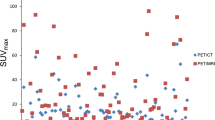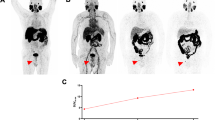Abstract
Purpose
Current standard of care conventional imaging modalities (CIM) such as X-ray computed tomography (CT) and bone scan can be limited for detection of metastatic prostate cancer and therefore improved imaging methods are an unmet clinical need. We evaluated the utility of a novel second-generation low molecular weight radiofluorinated prostate-specific membrane antigen (PSMA)-targeted positron emission tomography (PET) radiotracer, [18F]DCFPyL, in patients with metastatic prostate cancer.
Procedures
Nine patients with suspected prostate cancer recurrence, eight with CIM evidence of metastatic prostate cancer and one with biochemical recurrence, were imaged with [18F]DCFPyL PET/CT. Eight of the patients had contemporaneous CIM for comparison. A lesion-by-lesion comparison of the detection of suspected sites of metastatic prostate cancer was carried out between PET and CIM. Statistical analysis for estimated proportions of inter-modality agreement for detection of metastatic disease was calculated accounting for intra-patient correlation using general estimating equation (GEE) intercept-only regression models.
Results
One hundred thirty-nine sites of PET positive [18F]DCFPyL uptake (138 definite, 1 equivocal) for metastatic disease were detected in the eight patients with available comparison CIM. By contrast, only 45 lesions were identified on CIM (30 definite, 15 equivocal). When lesions were negative or equivocal on CIM, it was estimated that a large portion of these lesions or 0.72 (95 % confidence interval (CI) 0.55–0.84) would be positive on [18F]DCFPyL PET. Conversely, of those lesions negative or equivocal on [18F]DCFPyL PET, it was estimated that only a very small proportion or 0.03 (95 % CI 0.01–0.07) would be positive on CIM. Delayed 2-h-post-injection time point PET yielded higher tumor radiotracer uptake and higher tumor-to-background ratios than an earlier 1-h-post-injection time point.
Conclusions
A novel PSMA-targeted PET radiotracer, [18F]DCFPyL, was able to a large number of suspected sites of prostate cancer, many of which were occult or equivocal by CIM. This study provides strong preliminary evidence for the use of this second-generation PSMA-targeted PET radiotracer for detection of metastatic prostate cancer and lends further support for the importance of PSMA-targeted PET imaging in prostate cancer.






Similar content being viewed by others
References
Siegel R, Ma J, Zou Z, Jemal A (2014) Cancer statistics, 2014. Cancer J Clin 64:9–29
Jadvar H (2011) Prostate cancer: PET with 18F-FDG, 18F- or 11C-acetate, and 18F- or 11C-choline. J Nucl Med 52:81–89
Bauman G, Belhocine T, Kovacs M, Ward A, Beheshti M, Rachinsky I (2012) 18F-fluorocholine for prostate cancer imaging: a systematic review of the literature. Prostate Cancer Prostatic Dis 15:45–55
Beheshti M, Treglia G, Zakavi SR et al (2013) Application of 11C-acetate positron-emission tomography (PET) imaging in prostate cancer: systematic review and meta-analysis of the literature. Br J Urol Int. doi:10.1111/bju.12279
Evangelista L, Guttilla A, Zattoni F, Muzzio PC (2013) Utility of choline positron emission tomography/computed tomography for lymph node involvement identification in intermediate- to high-risk prostate cancer: a systematic literature review and meta-analysis. Eur Urol 63:1040–1048
Evangelista L, Zattoni F, Guttilla A, Saladini G, Colletti PM, Rubello D (2013) Choline PET or PET/CT and biochemical relapse of prostate cancer: a systematic review and meta-analysis. Clin Nucl Med 38:305–314
Fuccio C, Rubello D, Castellucci P, Marzola MC, Fanti S (2011) Choline PET/CT for prostate cancer: main clinical applications. Eur J Radiol 80:e50–e56
Mertens K, Slaets D, Lambert B, Acou M, De Vos F, Goethals I (2010) PET with (18)F-labelled choline-based tracers for tumour imaging: a review of the literature. Eur J Nucl Med Mol Imaging 37:2188–2193
Umbehr MH, Muntener M, Hany T, Sulser T, Bachmann LM (2013) The role of 11C-choline and 18F-fluorocholine positron emission tomography (PET) and PET/CT in prostate cancer: a systematic review and meta-analysis. Eur Urol 64:106–117
Schuster DM, Votaw JR, Nieh PT et al (2007) Initial experience with the radiotracer anti-1-amino-3-18F-fluorocyclobutane-1-carboxylic acid with PET/CT in prostate carcinoma. J Nucl Med 48:56–63
Schuster DM, Savir-Baruch B, Nieh PT et al (2011) Detection of recurrent prostate carcinoma with anti-1-amino-3-18F-fluorocyclobutane-1-carboxylic acid PET/CT and 111In-capromab pendetide SPECT/CT. Radiology 259:852–861
Wieser G, Mansi R, Grosu AL et al (2014) Positron emission tomography (PET) imaging of prostate cancer with a gastrin releasing peptide receptor antagonist—from mice to men. Theranostics 4:412–419
Sah BR, Burger IA, Schibli R et al (2015) Dosimetry and first clinical evaluation of the new 18F-radiolabeled bombesin analogue BAY 864367 in patients with prostate cancer. J Nucl Med 56:372–378
Venneti S, Dunphy MP, Zhang H et al (2015) Glutamine-based PET imaging facilitates enhanced metabolic evaluation of gliomas in vivo. Sci Transl Med 7:274ra17
Huang C, McConathy J (2013) Fluorine-18 labeled amino acids for oncologic imaging with positron emission tomography. Curr Top Med Chem 13:871–891
Cho SY, Gage KL, Mease RC et al (2012) Biodistribution, tumor detection, and radiation dosimetry of 18F-DCFBC, a low-molecular-weight inhibitor of prostate-specific membrane antigen, in patients with metastatic prostate cancer. J Nucl Med 53:1883–1891
Szabo Z, Mena E, Rowe SP et al (2015) Initial evaluation of [18F]DCFPyL for prostate-specific membrane antigen (PSMA)-targeted PET imaging of prostate cancer. Mol Imaging Biol 17:565–574
Afshar-Oromieh A, Malcher A, Eder M et al (2013) PET imaging with a [68Ga]gallium-labelled PSMA ligand for the diagnosis of prostate cancer: biodistribution in humans and first evaluation of tumour lesions. Eur J Nucl Med Mol Imaging 40:486–495
Viola-Villegas NT, Sevak KK, Carlin SD et al (2014) Noninvasive imaging of PSMA in prostate tumors with (89)Zr-labeled huJ591 engineered antibody fragments: the faster alternatives. Mol Pharm 11:3965–3973
Osborne JR, Green DA, Spratt DE et al (2014) A prospective pilot study of (89)Zr-J591/prostate specific membrane antigen positron emission tomography in men with localized prostate cancer undergoing radical prostatectomy. J Urol 191:1439–1445
Pandit-Taskar N, O’Donoghue JA, Beylergil V et al (2014) (8)(9)Zr-huJ591 immuno-PET imaging in patients with advanced metastatic prostate cancer. Eur J Nucl Med Mol Imaging 41:2093–2105
Afshar-Oromieh A, Hetzheim H, Kratochwil C et al (2015) The novel theranostic PSMA-ligand PSMA-617 in the diagnosis of prostate cancer by PET/CT: biodistribution in humans, radiation dosimetry and first evaluation of tumor lesions. J Nucl Med 56:1697–1705
Foss CA, Mease RC, Cho SY, Kim HJ, Pomper MG (2012) GCPII imaging and cancer. Curr Med Chem 19:1346–1359
Chang SS (2004) Overview of prostate-specific membrane antigen. Rev Urol 6(Suppl 10):S13–S18
Wright GL Jr, Grob BM, Haley C et al (1996) Upregulation of prostate-specific membrane antigen after androgen-deprivation therapy. Urology 48:326–334
Evans MJ, Smith-Jones PM, Wongvipat J et al (2011) Noninvasive measurement of androgen receptor signaling with a positron-emitting radiopharmaceutical that targets prostate-specific membrane antigen. Proc Natl Acad Sci U S A 108:9578–9582
Noss KR, Wolfe SA, Grimes SR (2002) Upregulation of prostate specific membrane antigen/folate hydrolase transcription by an enhancer. Gene 285:247–256
Perner S, Hofer MD, Kim R et al (2007) Prostate-specific membrane antigen expression as a predictor of prostate cancer progression. Hum Pathol 38:696–701
Ross JS, Sheehan CE, Fisher HA et al (2003) Correlation of primary tumor prostate-specific membrane antigen expression with disease recurrence in prostate cancer. Clin Cancer Res 9:6357–6362
Rowe SP, Gage KL, Faraj SF et al (2015) 18F-DCFBC PET/CT for PSMA-based detection and characterization of primary prostate cancer. J Nucl Med 56:1003–1010
Rowe SP, Macura KJ, Ciarallo A et al (2016) Comparison of prostate-specific membrane antigen-based 18F-DCFBC PET/CT to conventional imaging modalities for detection of hormone-naïve and castration-resistant metastatic prostate cancer. J Nucl Med 56:46–53
Chen Y, Pullambhatla M, Foss CA et al (2011) 2-(3-{1-Carboxy-5-[(6-[18F]fluoro-pyridine-3-carbonyl)-amino]-pentyl}-ureido)-pen tanedioic acid, [18F]DCFPyL, a PSMA-based PET imaging agent for prostate cancer. Clin Cancer Res 17:7645–7653
Yao V, Berkman CE, Choi JK, O’Keefe DS, Bacich DJ (2010) Expression of prostate-specific membrane antigen (PSMA), increases cell folate uptake and proliferation and suggests a novel role for PSMA in the uptake of the non-polyglutamated folate, folic acid. Prostate 70:305–316
Yao V, Parwani A, Maier C, Heston WD, Bacich DJ (2008) Moderate expression of prostate-specific membrane antigen, a tissue differentiation antigen and folate hydrolase, facilitates prostate carcinogenesis. Cancer Res 68:9070–9077
Team RC (2014) R: a language and environment for statistical computing. R Foundation for Statistical Computing, Vienna
Liang K-Y, Scott Z (1986) Longitudinal data analysis using generalized linear models. Biometrika 73:13–22
Eiber M, Maurer T, Souvatzoglou M et al (2015) Evaluation of hybrid 68Ga-PSMA Ligand PET/CT in 248 patients with biochemical recurrence after radical prostatectomy. J Nucl Med 56:668–674
Morigi JJ, Stricker PD, van Leeuwen PJ et al (2015) Prospective comparison of 18F-fluoromethylcholine versus 68Ga-PSMA PET/CT in prostate cancer patients who have rising PSA after curative treatment and are being considered for targeted therapy. J Nucl Med 56:1185–1190
Afshar-Oromieh A, Zechmann CM, Malcher A et al (2014) Comparison of PET imaging with a (68)Ga-labelled PSMA ligand and (18)F-choline-based PET/CT for the diagnosis of recurrent prostate cancer. Eur J Nucl Med Mol Imaging 41:11–20
Dietlein M, Kobe C, Kuhnert G et al (2015) Comparison of [F]DCFPyL and [ Ga]Ga-PSMA-HBED-CC for PSMA-PET imaging in patients with relapsed prostate cancer. Mol Imaging Biol 17:575–584
Sanchez-Crespo A (2013) Comparison of gallium-68 and fluorine-18 imaging characteristics in positron emission tomography. Appl Radiat Isot 76:55–62, Including data, instrumentation and methods for use in agriculture, industry and medicine
Acknowledgments
We would like to thank funding from the Prostate Cancer Foundation-Young Investigator Award, CA134675, CA184288, CA103175, CA183031. We thank Akimosa Jeffrey-Kwanisai and Yavette Morton for providing clinical coordination of this trial.
Author information
Authors and Affiliations
Corresponding author
Ethics declarations
Conflict of Interest
MGP, RCM, and YC are co-inventors on a US Patent covering [18F]DCFPyL and as such are entitled to a portion of any licensing fees and royalties generated by this technology. This arrangement has been reviewed and approved by the Johns Hopkins University in accordance with its conflict of interest policies.
Electronic supplementary material
Below is the link to the electronic supplementary material.
ESM 1
(PDF 2555 kb)
Rights and permissions
About this article
Cite this article
Rowe, S.P., Macura, K.J., Mena, E. et al. PSMA-Based [18F]DCFPyL PET/CT Is Superior to Conventional Imaging for Lesion Detection in Patients with Metastatic Prostate Cancer. Mol Imaging Biol 18, 411–419 (2016). https://doi.org/10.1007/s11307-016-0957-6
Published:
Issue Date:
DOI: https://doi.org/10.1007/s11307-016-0957-6




